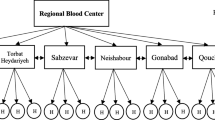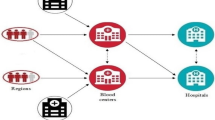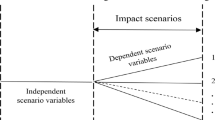Abstract
In recent years, attention to blood supply chain in disaster circumstances has significantly increased. Disasters, especially earthquakes, have adverse consequences such as destruction, loss of human lives, and undermining the effectiveness of health services. This research considers a six-echelon blood supply chain which consists of donors, blood collection centers (permanent and temporary), regional blood centers, local blood centers, regional hospitals, and local hospitals. For the first time, we considered that helicopters could carry blood from regional hospitals to local hospitals and return injured people that cannot be treated in local hospitals to regional hospitals due to the limited capacity. In addition to the above, different transportations with limited capacities regarded, where the optimal number of required transportations equipment determined after the solution process. This research aims to avoid the worst consequences of a disaster using a neural-learning process to gain from past experiences to meet new challenges. For this aim, this article considers three objective functions that are minimizing total transportation time and cost while minimizing unfulfilled demand. The model implemented based on a real-world case study from the most recent earthquake in the Iran–Iraq border which named the deadliest earthquake of 2017. Based on our results, we learned how to design an efficient blood supply chain that can fulfill hospitals blood demand quickly with the lowest cost using simulation and optimization processes. Moreover, we performed in-depth analyses and provided essential managerial insights at last.







Similar content being viewed by others
References
Ahmadi, A., & Bazargan-Hejazi, S. (2018). 2017 Kermanshah earthquake; lessons learned. Journal of Injury and Violence Research,10(1), 1.
Arvan, M., Tavakkoli-Moghaddam, R., & Abdollahi, M. (2015). Designing a bi-objective and multi-product supply chain network for the supply of blood. Uncertain Supply Chain Management,3(1), 57–68.
Balcik, B., & Beamon, B. M. (2008). Facility location in humanitarian relief. International Journal of Logistics,11(2), 101–121.
Beliën, J., & Forcé, H. (2012). Supply chain management of blood products: A literature review. European Journal of Operational Research,217(1), 1–16.
Cheraghi, S., & Hosseini-Motlagh, S. M. (2017). Optimal blood transportation in disaster relief considering facility disruption and route reliability under uncertainty. International Journal of Transportation Engineering,4(3), 225–254.
Christopher, M. (2016). Logistics and supply chain management. London: Pearson.
Cozzolino, A. (2012). Humanitarian logistics and supply chain management. In Humanitarian logistics, Springer, Berlin, pp. 5–16.
Ebrahimi, M., & Rahmani, D. (2019). A five-dimensional approach to sustainability for prioritizing energy production systems using a revised GRA method: A case study. Renewable Energy,135, 345–354.
Eskandari-Khanghahi, M., Tavakkoli-Moghaddam, R., Taleizadeh, A. A., & Amin, S. H. (2018). Designing and optimizing a sustainable supply chain network for a blood platelet bank under uncertainty. Engineering Applications of Artificial Intelligence,71, 236–250.
Fahimnia, B., Jabbarzadeh, A., Ghavamifar, A., & Bell, M. (2017). Supply chain design for efficient and effective blood supply in disasters. International Journal of Production Economics,183, 700–709.
Fazli-Khalaf, M., Khalilpourazari, S., & Mohammadi, M. (2017). Mixed robust possibilistic flexible chance constraint optimization model for emergency blood supply chain network design. Annals of Operations Research. https://doi.org/10.1007/s10479-017-2729-3.
Geospatial Information Authority of Japan. (2017). https://www.gsi.go.jp/ENGLISH/.
Habibi-Kouchaksaraei, M., Paydar, M. M., & Asadi-Gangraj, E. (2018). Designing a bi-objective multi-echelon robust blood supply chain in a disaster. Applied Mathematical Modelling,55, 583–599.
Hosseinifard, Z., & Abbasi, B. (2018). The inventory centralization impacts on sustainability of the blood supply chain. Computers & Operations Research,89, 206–212.
Hosseini-Motlagh, S. M., Samani, M. R. G., & Cheraghi, S. (2019). Robust and stable flexible blood supply chain network design under motivational initiatives. Socio-Economic Planning Sciences. https://doi.org/10.1016/j.seps.2019.07.001.
Iranian seismological center. (2017). http://irsc.ut.ac.ir/.
Jabbarzadeh, A., Fahimnia, B., & Seuring, S. (2014). Dynamic supply chain network design for the supply of blood in disasters: A robust model with real world application. Transportation Research Part E: Logistics and Transportation Review,70, 225–244.
Jacobs, F. R., Chase, R. B., & Lummus, R. R. (2014). Operations and supply chain management (pp. 533–535). New York, NY: McGraw-Hill.
Karasözen, B., Küçükseyhan, T., & Uzunca, M. (2017). Structure preserving integration and model order reduction of skew-gradient reaction–diffusion systems. Annals of Operations Research,258(1), 79–106.
Khalilpourazari, S., & Khalilpourazary, S. (2017). A lexicographic weighted Tchebycheff approach for multi-constrained multi-objective optimization of the surface grinding process. Engineering Optimization,49(5), 878–895.
Khalilpourazari, S., & Khalilpourazary, S. (2018a). Optimization of time, cost and surface roughness in grinding process using a robust multi-objective dragonfly algorithm. Neural Computing and Applications,29, 1321–1336.
Khalilpourazari, S., & Khalilpourazary, S. (2018b). SCWOA: An efficient hybrid algorithm for parameter optimization of multi-pass milling process. Journal of Industrial and Production Engineering,35(3), 135–147.
Khalilpourazari, S., & Khamseh, A. A. (2017). Bi-objective emergency blood supply chain network design in earthquake considering earthquake magnitude: A comprehensive study with real world application. Annals of Operations Research. https://doi.org/10.1007/s10479-017-2588-y.
Khalilpourazari, S., Mirzazadeh, A., Weber, G. W., & Pasandideh, S. H. R. (2019a). A robust fuzzy approach for constrained multi-product economic production quantity with imperfect items and rework process. Optimization. https://doi.org/10.1080/02331934.2019.1630625.
Khalilpourazari, S., Naderi, B., & Khalilpourazary, S. (2019b). Multi-objective stochastic fractal search: A powerful algorithm for solving complex multi-objective optimization problems. Soft Computing. https://doi.org/10.1007/s00500-019-04080-6.
Khalilpourazari, S., & Pasandideh, S. H. R. (2018). Multi-objective optimization of multi-item EOQ model with partial backordering and defective batches and stochastic constraints using MOWCA and MOGWO. Operational Research. https://doi.org/10.1007/s12351-018-0397-y.
Khalilpourazari, S., & Pasandideh, S. H. R. (2019). Modeling and optimization of multi-item multi-constrained EOQ model for growing items. Knowledge-Based Systems,164, 150–162.
Khalilpourazari, S., Pasandideh, S. H. R., & Ghodratnama, A. (2018). Robust possibilistic programming for multi-item EOQ model with defective supply batches: Whale Optimization and Water Cycle Algorithms. Neural Computing and Applications. https://doi.org/10.1007/s00521-018-3492-3.
Khalilpourazari, S., Pasandideh, S. H. R., & Niaki, S. T. A. (2019c). Optimizing a multi-item economic order quantity problem with imperfect items, inspection errors, and backorders. Soft Computing. https://doi.org/10.1007/s00500-018-03718-1.
Kohneh, J. N., Teymoury, E., & Pishvaee, M. S. (2016). Blood products supply chain design considering disaster circumstances (case study: Earthquake disaster in Tehran). Journal of Industrial and Systems Engineering,9, 51–72.
Mizutani, E., & Dreyfus, S. (2017). Totally model-free actor-critic recurrent neural-network reinforcement learning in non-Markovian domains. Annals of Operations Research,258(1), 107–131.
Mohammadi, M., & Khalilpourazari, S. (2017). Minimizing makespan in a single machine scheduling problem with deteriorating jobs and learning effects. In Proceedings of the 6th international conference on software and computer applications, ACM, pp. 310–315.
Mohammadian-Behbahani, Z., Jabbarzadeh, A., & Pishvaee, M. S. (2019). A robust optimisation model for sustainable blood supply chain network design under uncertainty. International Journal of Industrial and Systems Engineering,31(4), 475–494.
Nagurney, A., Masoumi, A. H., & Yu, M. (2012). Supply chain network operations management of a blood banking system with cost and risk minimization. Computational Management Science,9(2), 205–231.
Or, I., & Pierskalla, W. P. (1979). A transportation location-allocation model for regional blood banking. AIIE Transactions,11(2), 86–95.
Pasandideh, S. H. R., & Khalilpourazari, S. (2018). Sine cosine crow search algorithm: a powerful hybrid meta heuristic for global optimization. arXiv preprint arXiv:1801.08485.
Pervin, M., Roy, S. K., & Weber, G. W. (2018). Analysis of inventory control model with shortage under time-dependent demand and time-varying holding cost including stochastic deterioration. Annals of Operations Research,260(1–2), 437–460.
Pierskalla, W. P. (2005). Supply chain management of blood banks. In Operations research and health care, Springer, Boston, MA, pp. 103–145.
Rahmani, D. (2018). Designing a robust and dynamic network for the emergency blood supply chain with the risk of disruptions. Annals of Operations Research. https://doi.org/10.1007/s10479-018-2960-6.
Rahmani, D., Zandi, A., Behdad, S., & Entezaminia, A. (2019). A light robust model for aggregate production planning with consideration of environmental impacts of machines. Operational Research. https://doi.org/10.1007/s12351-019-00451-x.
Rahmani, D., Zandi, A., Peyghaleh, E., & Siamakmanesh, N. (2018). A robust model for a humanitarian relief network with backup covering under disruptions: A real world application. International Journal of Disaster Risk Reduction,28, 56–68.
Roy, S. K., Maity, G., Weber, G. W., & Alparslan Gök, S. Z. (2017). Conic scalarization approach to solve multi-choice multi-objective transportation problem with interval goal. Annals of Operations Research,253(1), 599–620.
Şahin, G., Süral, H., & Meral, S. (2007). Locational analysis for regionalization of Turkish Red Crescent blood services. Computers & Operations Research,34(3), 692–704.
Şahinyazan, F. G., Kara, B. Y., & Taner, M. R. (2015). Selective vehicle routing for a mobile blood donation system. European Journal of Operational Research,245(1), 22–34.
Salehi, F., Mahootchi, M., & Husseini, S. M. M. (2017). Developing a robust stochastic model for designing a blood supply chain network in a crisis: A possible earthquake in Tehran. Annals of Operations Research,1, 1. https://doi.org/10.1007/s10479-017-2533-0.
Samani, M. R. G., & Hosseini-Motlagh, S. M. (2018). An enhanced procedure for managing blood supply chain under disruptions and uncertainties. Annals of Operations Research. https://doi.org/10.1007/s10479-018-2873-4.
Samani, M. R. G., Torabi, S. A., & Hosseini-Motlagh, S. M. (2018). Integrated blood supply chain planning for disaster relief. International Journal of Disaster Risk Reduction,27, 168–188.
Şaylı, M., & Yılmaz, E. (2017). Anti-periodic solutions for state-dependent impulsive recurrent neural networks with time-varying and continuously distributed delays. Annals of Operations Research,258(1), 159–185.
Sha, Y., & Huang, J. (2012). The multi-period location-allocation problem of engineering emergency blood supply systems. Systems Engineering Procedia,5, 21–28.
Steuer, R. E. (1986). Multiple criteria optimization. In Theory, computation and applications, Willey, New York.
Tabatabaie, M., Ardalan, A., Abolghasemi, H., Naieni, K. H., Pourmalek, F., Ahmadi, B., et al. (2010). Estimating blood transfusion requirements in preparation for a major earthquake: The Tehran, Iran study. Prehospital and Disaster Medicine,25(3), 246–252.
Valinejad, F., & Rahmani, D. (2018). Sustainability risk management in the supply chain of telecommunication companies: A case study. Journal of Cleaner Production,203, 53–67.
Yerlikaya-Özkurt, F., Askan, A., & Weber, G. W. (2014). An alternative approach to the ground motion prediction problem by a non-parametric adaptive regression method. Engineering Optimization,46(12), 1651–1668.
Yerlikaya-Özkurt, F., Askan, A., & Weber, G. W. (2016). A hybrid computational method based on convex optimization for outlier problems: Application to earthquake ground motion prediction. Informatica,27(4), 893–910.
Zahiri, B., & Pishvaee, M. S. (2017). Blood supply chain network design considering blood group compatibility under uncertainty. International Journal of Production Research,55(7), 2013–2033.
Zahiri, B., Torabi, S. A., Mohammadi, M., & Aghabegloo, M. (2018). A multi-stage stochastic programming approach for blood supply chain planning. Computers & Industrial Engineering,122, 1–14.
Author information
Authors and Affiliations
Corresponding author
Additional information
Publisher's Note
Springer Nature remains neutral with regard to jurisdictional claims in published maps and institutional affiliations.
Appendix
Appendix
See Tables 4, 5, 6, 7, 8, 9, 10, 11, 12, 13 and 14.
Rights and permissions
About this article
Cite this article
Khalilpourazari, S., Soltanzadeh, S., Weber, GW. et al. Designing an efficient blood supply chain network in crisis: neural learning, optimization and case study. Ann Oper Res 289, 123–152 (2020). https://doi.org/10.1007/s10479-019-03437-2
Published:
Issue Date:
DOI: https://doi.org/10.1007/s10479-019-03437-2




